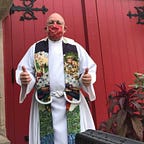Celtic Venn: The Interwoven Nature of Wellness
With all wisdom and insight he (God) has made known to us the mystery of his will, according to his good pleasure that he set forth in Christ, as a plan for the fullness of time, to gather up all things in him, things in heaven and things on earth. In Christ we have also obtained an inheritance, having been destined according to the purpose of him who accomplishes all things according to his counsel and will, so that we, who were the first to set our hope on Christ, might live for the praise of his glory.
Episcopal Bishop — The Rt. Rev. Dr. Audrey Scanlan, discussed circles in a sermon she offered to the congregations I serve. She illuminated the interwoven nature of our relationships with one another and God as people, congregations, and The Church. She used “Venn diagram” imagery. The typical definition of a Venn Diagram describes the image as a “logical relation between sets.” I suggest that, for our purposes, as people who seek wholeness and wellness, a Venn Diagram is more than logical. It is spiritual, and psychological, as well as pragmatic.
A first Venn figure that fascinates me is the Triquetra This is a triangular “three-sided” figure of arcs that artists use to depict an interwoven relationship.
You may know it is as a “Celtic Knot” (often used to describe the Holy Trinity). It offers an understanding that all aspects of our lives (holistically) are active — dynamic — and hold potential for an endless conduit of grace. Circles are timeless and alive whereas lines are defined and static (at least for me).
I have become increasingly interested in Circle Way practices since I first heard of the process at a Consortium of Endowed Episcopal Parishes (CEEPNetwork) gathering in early 2018. I invite you to download the book.
I think idealistically of how Jesus and his disciples as well as early Christians met in circles. Then, as now, a circle when properly hosted and bounded creates a culture of conversations wherein everyone speaks intentionally, listens, attentively, and allows for time and space to coalesce around purpose and praxis. The people involved commit themselves toward becoming leaders rather than managers. What they discuss within their container is theirs for safekeeping albeit what they agree to bring out of the circle into their communities and back in from their communities becomes the lifeline to sharing learning, wellness, and blessing. In spiritual terms, the work is not only “profane.” A circle invites God’s presence and presents because the faithful people open themselves up to the synergy that is a constant Divine resource in and beyond all participant’s human senses and limitations.
Here’s another cool Venn (Circular) diagram. Why do you wake up in the morning? Why do you dedicate time, energy, finances, and most other aspects of your being to your mortal and eternal lives? Does this “purpose” equate to how you earned or earn a paycheck? If so, I invite you to contemplate the nature of your Venn Diagram more intentionally.
Ikigai, according to author Mieko Kamiya, suggests that the sum of small joys in everyday life results in living a more joyous life throughout our days. The author of Ephesians points to a similar understanding. Christians who place their faith, hope, and love upon God’s will discover their inheritance to participate in accomplishing Christ’s plan for themselves as well as for their neighbors and the broader world, and consequently to God in the returning circular arcs they abide in.
Let me sum this concept with this this last diagram. Let us take a look at these three circles. Consider what three aspects of your life are a set into and of themselves. Matters of physical health might make up one such circle. Matters of spiritual health might make up another. Matters of intellectual health might make up a third one. If we were to contemplate and create consciously, we would discover that there is overlap and congruency between circles. “Sweet spots” come to the surface as well as shadows worthy of our response. Ikigai, purpose of life, wholeness all become more realistic — especially when we determine what we have the greatest chance of influencing within the spheres that we live daily in.
Our organizations and faith communities may join in on sharing this wisdom to discover their own purpose and reasons for being. In my work, I imagine us expanding the lines and depths of the circles we form to craft a more purposeful hub in the wheels we spin on Christ’ behalf. These lifegiving circles of faithful people will be share their insights with one another through a variety of conversations and resources. And, as Bishop Scanlan, mentioned, the consequences of this Spirit-led, Christ-inspired work will unveil much we did not know about ourselves, our God, and the world we live in.
Blessings along The Way, Jim+
